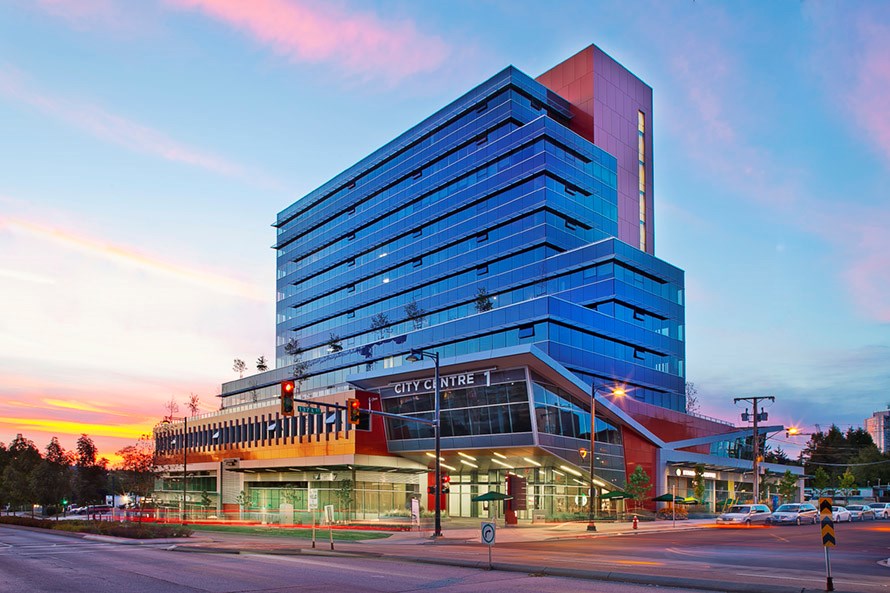A cutting edge-tech tool that sounded like pure science fiction only a few years ago, virtual reality (VR) and augmented reality (AR) are rapidly becoming the de facto standard in real estate marketing.
VR is evolving so rapidly that it seems the construction industries are discovering new possibilities almost daily.
Dogu Taskiran, CEO of Stambol Studios, believes the health sciences will become one of VR’s largest markets. Stambol Studios is the company behind a virtual depiction of Surrey’s Health and Technology District, an eight-building campus located in the city’s new downtown.
“You can’t showcase an entire district when there’s only one building complete and a second one just started – which was the case when we got involved in 2017,” he said. “We built an app that encompasses the first five buildings – the architects haven’t designed the final three yet or we would have included them as well.”
Since any environment can be replicated in the virtual world, Jamie Henry from Draft on Site Design Studio, said hospitals and medical training facilities are just one example of companies potentially saving hundreds of thousands of dollars by eliminating the “if only we’d realized this ahead of time” syndrome.
“We can create a virtual operating theatre where doctors can walk round the space, use the equipment to make sure every piece of equipment fits and is located in the correct location.”
Opened in May, the company’s new office will have a state-of-the-art, 35 by 35-foot VR studio where clients can experience anything from a studio condo to an entire university campus.
“And think about how a fitness facility could use VR to differentiate themselves,” Taskiran added. “Their clients could take part in the Tour de France or an IronMan marathon. It makes fitness fun and adds value without taking up extra space.”
David Li, co-founder of uForis VR, said virtual reality’s ability to completely immerse participants into an environment is going to become indispensable as a tool for interior designers in commercial real estate development, right down to the type of natural light a building will receive.
“For example, a gym might want morning light to be more inspiring while a pub with a patio might need more afternoon and early- evening light to attract the after-work crowd. Using virtual reality, we can dial it in as specifically as a certain day to see what mood the natural light will create – a big advance on guestimating the natural light a south-facing location on a slope would receive.”
Now under construction in Chilliwack, Molson’s newest 450,000-square-foot brewery began life in VR where senior management were able to weigh in on how the structure’s systems integrated – or not.
“It gave the team an opportunity to identify areas that could be improved and confirm details that worked,” said Bill Tucker, CEO at Omicron. “For example, on paper or another 2D representation, it could appear there’s plenty of space to move product along a corridor. But when you ‘walk’ through that corridor, you might discover it’s actually not quite wide enough.”
Many in the multi-family marketing sector have already embraced VR. “Presentation centres are costly to build – easily $200,000 to $300,000, even more for a high-end project,” Taskiran noted. “That’s an investment with a limited lifespan and is only available to consumers during certain hours. With virtual reality, you have an open house available to anyone, anywhere in the world. It’s accessible 24-7, costs a fraction of the price and can be updated on the fly.” As a bonus, if a Vancouver developer decided to open a second presentation centre outside the Lower Mainland (or vice versa), there’s no expensive second scale model required—in fact, there’s no expensive scale model required, period.
In Abbotsford, B.C.’s second Canuck Place Children’s Hospice saw a creative opportunity to integrate ongoing fundraising into its existing VR tool box. “Potential donors can tour the facility without intruding into families’ privacy. The experience of what Canuck Place does can be almost impossible to understand without ‘being there’,” said Brett Youngberg, general manager of SeeVirtual Marketing & Photography, adding that it took just over a week to create a virtual model of the approximately 40,000-square-foot children’s hospice.
“Virtual reality is no longer science fiction, it’s science fact – a story that needs to be told,” Tucker said. “I believe that in the not-so-distant future, every builder and developer will use this tool because it just makes good sense.”



